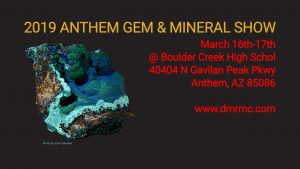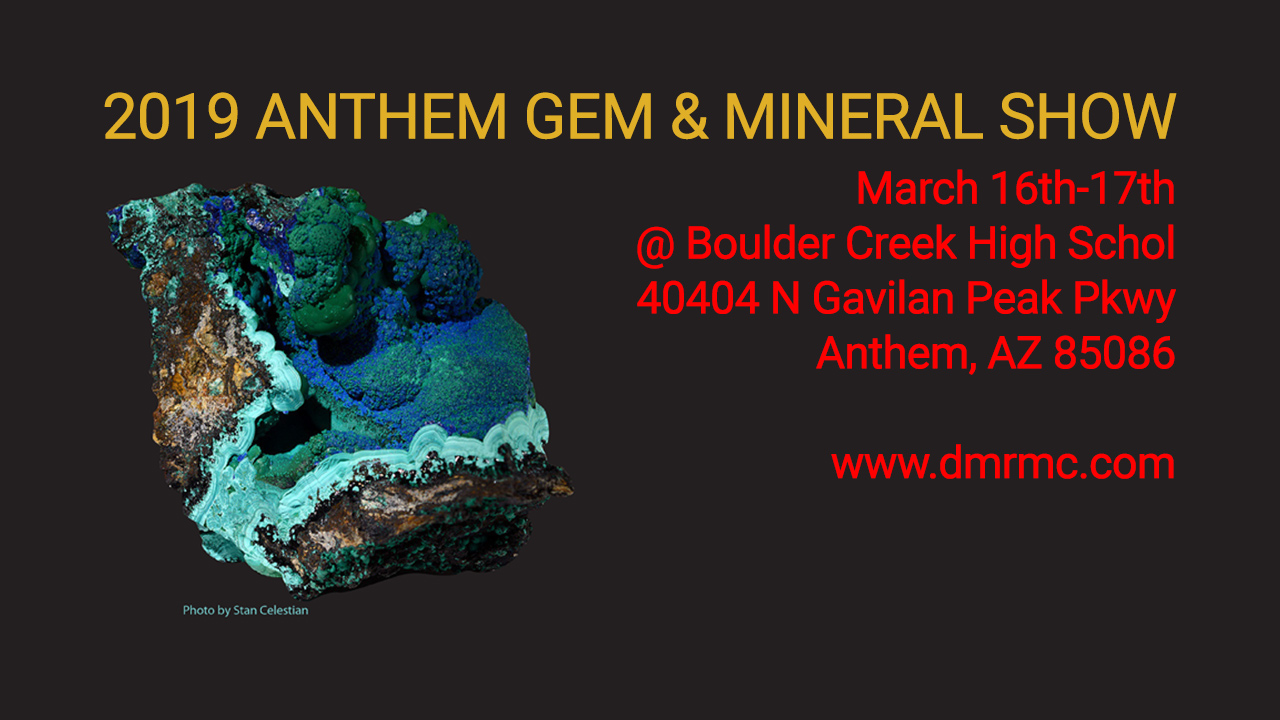2019 ANTHEM GEM & MINERAL SHOW

March 16th Saturday 9am—5pm
March 17th Sunday 10am—4pm
Anthem Mineral Show Coupon
Boulder Creek High School
40404 N Gavilan Peak Pkwy
Anthem, AZ 85086
Kids events, Gems, Minerals, Fossils, Jewelry,
Fluorescents, Beads Wire Wrapping, Geodes,
Adults $4, Seniors and Students $2,
Children 12 and under FREE
Sponsored by
Daisy Mountain Rock & Mineral Club
$1.00 Off Admission with this coupon
www.dmrmc.com
Anthem Mineral Show Coupon
LOCATED IN ANTHEM, ARIZONA, THE PURPOSE and MISSION OF DAISY MOUNTAIN ROCK & MINERAL CLUB IS TO PROMOTE AND FURTHER AN INTEREST IN GEOLOGY, MINERALOGY AND LAPIDARY ARTS, THROUGH EDUCATION, FIELD EXPERIENCES, PUBLIC SERVICE AND FRIENDSHIP. We Welcome VISITORS!
Beginning in 2010, Daisy Mountain Rock & Mineral Club was organized as a non-profit corporation to further the interest and educate the public in the many geological features of the terrain located in the mid-deserts located around Phoenix, Arizona.
Our founders, geologists and educators Herb Jacobson, Robert Salter, Keith Martin and Jay Yett were joined by “rock-hounds” Dan Janko, Edward Winbourne and Joan Jamtass in 2009 to create a non-profit corporation dedicated to sharing their knowledge and experience in geological formations.
From http://www.dmrmc.com/:
MINERALOGY: THE STUDY OF MINERALS
A mineral is naturally occurring, inorganic (it has not lived), crystalline solid, with a definite chemical formula (or formula range). In contrast, a rock is generally a combination of minerals or organic remains, and therefore does not have a unique, specific, or consistent chemical composition.
There are over 5,421 known mineral species. Over 5,208 of these have been approved by the International Mineralogical Association (IMA). It is worthy of note that since silicon and oxygen constitute approximately 75% of the Earth’s crust, the 1000 silicate minerals comprise over 90% of the minerals of the crust– the two most common being quartz and feldspar.
Minerals are identified by their physical and chemical properties:
*crystal structure (there are 7 systems –isometric, tetragonal, orthorhombic, hexagonal, rhombohedral, monoclinic, and triclinic)
*crystal form (cubic, tetrahedral, rhombohedral…)
*habit (blocky, arborescent, acicular…),
*color,
*luster (how a mineral reflects light–adamantine, vitreous, resinous, greasy, metallic…,)
*hardness (a measure of a mineral’s scratchability),
*cleavage (a flat, repeatable break determined by the atomic structure) or
*fracture (irregular, non-repeatable break characteristic of minerals with bonding equal in all directions),
*tenacity (a description of a mineral’s resistance to breaking or deformation– brittle, malleable, ductile, sectile, elastic, plastic)
*diaphaneity (how a mineral transmits light– transparent, translucent, opaque),
*specific gravity (a comparison of a mineral’s weight to that of an equal volume of water) , and
*special characteristics: magnetism, reaction to acid, taste, smell, radioactivity
*chemical composition (there are 6 basic chemical classes of minerals – native elements, sulfides, oxides, halides, carbonates, silicates, phosphates)

